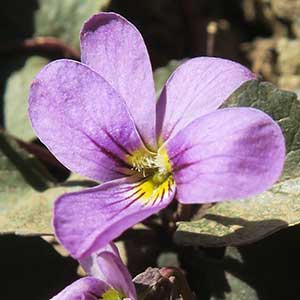Viola bakeri
Viola flettii
Baker's violet, yellow prairie violet
Flett's violet, Olympic violet, rock violet
1–4, usually erect, sometimes prostrate or decumbent, leafy proximally and distally, usually puberulent, from usually vertical, subligneous rhizome.
1–3, ascending to erect, mostly glabrous, on caudex from fleshy rhizome.
basal and cauline;
basal: 1–4;
stipules adnate to petiole, forming 2 linear-lanceolate wings, margins entire, apex of each wing free, acute to acuminate;
petiole 1–15.4 cm, glabrous or puberulent;
blade lanceolate, oblanceolate, or elliptic, rarely ovate, 1.8–8.8 × 0.7–3.9 cm, thin, base attenuate, often oblique, margins usually entire, sometimes with a few sharp teeth or crenulate, ciliate, apex acute to obtuse, mucronulate, surfaces glabrous or puberulent on margins or veins;
cauline similar to basal except: stipules ovate to lanceolate, margins entire or lacerate, sometimes with glandular projections, apex with 2–3 projections;
petiole 1.5–7.5 cm;
blade 1.9–6.7 × 0.5–1.6 cm.
basal and cauline;
basal: 1–3;
stipules linear-lanceolate, margins entire or with glandular processes, apex acuminate;
petiole 1.5–9.7 cm, mostly glabrous;
blade purple-tinted and –veined, broadly reniform to ovate, 0.9–2.4 × 1.2–4 cm, base cordate, margins finely crenate-serrate, eciliate, apex acute to obtuse, surfaces glabrous or sparsely pubescent along veins adaxially;
cauline similar to basal except: stipules ovate to lanceolate, margins entire or shallowly laciniate;
petiole 0.7–5.9 cm, usually glabrous;
blade 0.8–2.1 × 1.2–3.1 cm.
1.5–11.6 cm, glabrous or pubescent.
1.8–7.1 cm, usually glabrous.
sepals lanceolate, margins eciliate, auricles 0.5–1 mm;
petals deep lemon-yellow adaxially, upper 2 often brownish purple abaxially, lower 3 dark brown- to brownish purple-veined, lateral 2 sparsely bearded, lowest 6–14 mm, spur yellow, gibbous, 1–2 mm;
style head bearded; cleistogamous flowers axillary.
sepals lanceolate, margins eciliate, auricles 0.5–1.5 mm;
petals soft reddish violet on both surfaces, all with yellow area basally, lower 3 dark violet-veined, lateral 2 bearded, lowest with white around yellow area, 10–15 mm, spur yellow, gibbous, 0.5–2 mm;
style head bearded; cleistogamous flowers axillary.
spherical to ovoid, 5–10 mm, usually glabrous, rarely finely puberulent.
± spherical, 5–9 mm, glabrous.
light to medium brown or dark red-brown, 2.6–3.1 mm, elaiosome not covering funiculus.
dark brown to brownish purple, 2.5–3 mm.
= 48.
Viola bakeri
Viola flettii
M. S. Baker (1957) wrote that Viola bakeri flowers were often without a brownish tinge on the back. Subsequent collections have shown that the upper two petals of V. bakeri are often brownish purple abaxially and thus this characteristic cannot be used to distinguish V. bakeri from V. praemorsa, as previously done (P. A. Munz 1959; C. L. Hitchcock et al. 1955–1969, vol. 3).
Greene wrote in his description of Viola bakeri that the whole plant was glabrous; he did not mention leaf margins. M. S. Baker (1957) examined the type specimen at UC and apparently was the first to document that its leaf margins are entire. He also noted that under magnification the leaves are ciliate and more or less puberulent. D. M. Fabijan et al. (1987) stated that margins were always entire and ciliate and more or less pubescent throughout. Some collections of V. bakeri
from California have leaves with a sharp point or two on the margin, or crenulations on some portion of the basal or cauline blade margins.
(Discussion copyrighted by Flora of North America; reprinted with permission.)
Viola flettii is endemic to the Olympic Mountains of northwestern Washington. C. S. McCreary (2005) noted that although morphologically and ecologically distinct, V. cuneata, V. flettii, and V. ocellata are closely related.
(Discussion copyrighted by Flora of North America; reprinted with permission.)


